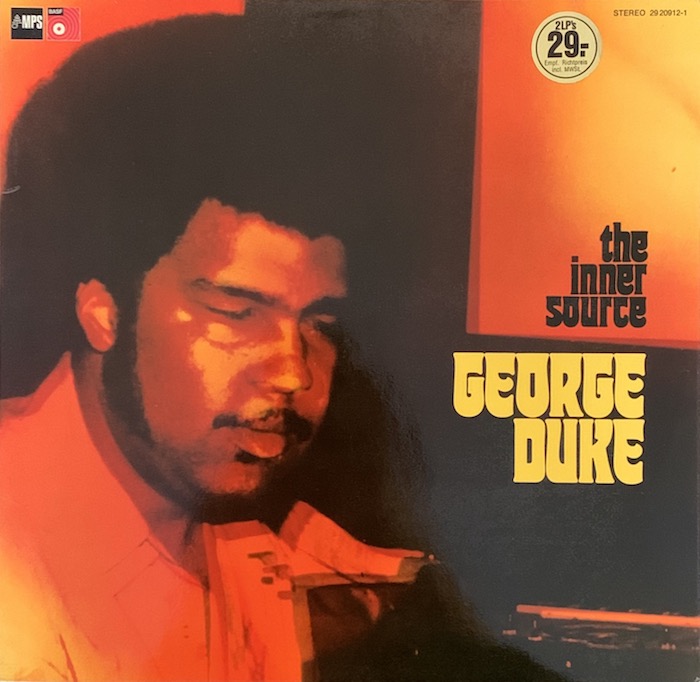
Our last post looked at Billy Cobham’s fusion classic ‘Heather’ from his album Crosswinds (1974) which featured the mellow tones of keyboardist George Duke. Flashing back a couple of years earlier to January 1971, a young George Duke had just left Frank Zappa’s group The Mothers Of Invention and joined saxophonist Cannonball Adderley’s new quintet, replacing pianist Joe Zawinul. The months that followed would prove formative for this young pianist and in this year he recorded two albums: Solus and The Inner Source, originally intended to be two separate albums but were later merged, released on German jazz label MPS in 1973.
The first of these two albums Solus was recorded soon after he joined Cannonball Adderley and marked a shift in his musical responsibilities from performer to also the roles of composer and arranger. Written for trio, this album featured two of Duke’s old musical friends, John Heard on bass and Dick Berk on drums. The familiarity of the players can immediately be heard in the warmth and intimacy of the music.
‘Au Right’ has a funky soul-jazz feel whilst other tracks such as ‘Love Reborn’, ‘So There You Go’, ‘Solus’ and ‘The Followers’ take a more traditional approach drawing on post-bop and modal sounds. One of the most interesting tracks of the session is ‘Nigerian Numberuma’ (translation: Nigerian Number Runner) which was a composition that Duke originally played with Cannonball where Duke experiments with electronic textures using a Rhodes, echoplex and ring modulator. Fans of Duke’s later albums for MPS will no doubt notice a similarity between this and his fantastic track ‘North Beach’ from his album Faces In Reflection, as well as the fusion experiments of Herbie Hancock’s Mwandishi band.
The second album entitled The Inner Source, was recorded later that year and saw Duke start to free up, stretch out and experiment with fusion arrangements, using electronic instruments such as the Rhodes and Wurlitzer, as well as playing trombone on all of the horn tunes. He also expanded the band to feature Cuban horn player Luis Gasca and conga player Armando Peroza, both of whom had played with Santana and added a latin flavour to the band, most notably on the track ‘My Soul’. Duke himself noted a progression in his playing from Solus to The Inner Source, no doubt due to the 10 months between the two albums spent playing with Adderley. On The Inner Source, arrangements were more complex and many tracks featured a greater level of improvisation.
Both these albums are musically very strong and share similarities to the sophisticated early fusion experiments of Joe Henderson’s Power To The People (1969) and Nucleus’ Elastic Rock (1970). As Duke himself later remarked:
“I used to call my music Multi-Stylistic. I grew up listening to all kinds of music, and I didn’t see why I should be kept in a box musically. I felt, and still feel, that there is intrinsic worth in all forms of music, even the simpler forms. I’ve always wanted to bring cultures and music together – you know, make a nice stew.”
One of the album’s standout tracks is ‘Peace’ which originally was to feature on Solus. A beautiful, deep and meditative composition, ‘Peace’ sees Duke and his group craft a slow moving, ambient soundscape. As Falk remarks in the liner notes, ‘the pattern of the chord changes is set but everything else was left to the individual performer’. The ambient and improvisational nature of this track is reminiscent of Pharoah Sanders’ ‘Greeting To Saud (Brother McCoy Tyner)’, a track which we have previously discussed. Both tracks are similar in that they feature a pianist soloing over a slow moving bed of sound. But whilst the music of Sanders and his group has an open and outward facing feel, Duke’s composition feels more intimate and introspective, taking on a darker and mysterious edge with Duke’s glistening Rhodes lines shifting in and out of focus.
After the release of The Inner Source, Duke followed with a string of musically adventurous albums on MPS where he continued to build on his ‘multi-stylistic’ approach to fusion whilst also developing as a singer-songwriter. In 1979, Duke released A Brazilian Love Affair which was a huge hit and has become arguably his most famous and popular album. Throughout the 80s Duke transitioned to a more radio friendly sound full of disco, boogie and R&B influences and became more active as a producer for other artists.
It goes without saying that 2020 has been a hell of a year and has left many of us feeling stressed, tired and worn down. So put on those headphones, look inwards and find that moment of musical peace.
For more deep electric piano from Duke and others, be sure to explore our ‘One For The Rhodes’ playlist over on Spotify.
If you enjoyed this post and want to stay updated, make sure to subscribe to our Spotify playlist and follow us on Instagram and Twitter!
